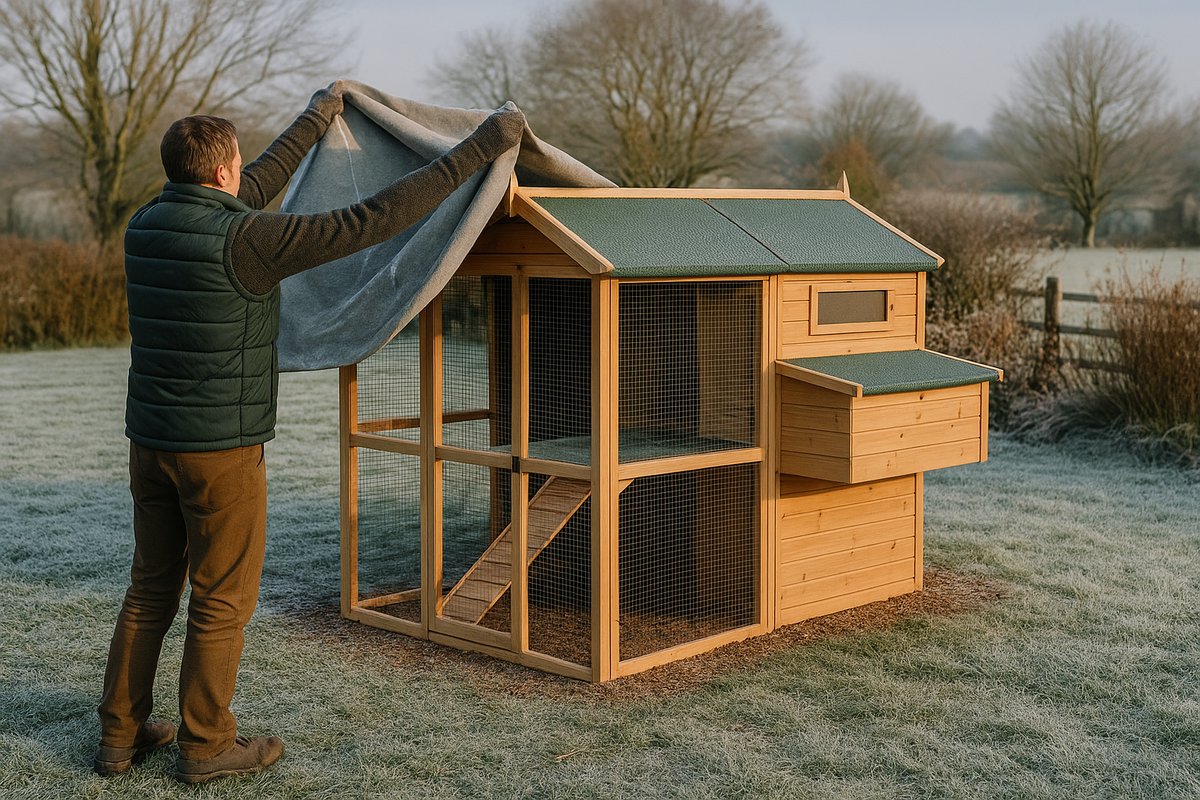
Preparing a Chicken Coop for Winter Weather in the UK
Winter in the UK can be challenging for chickens kept in your garden, let alone humans getting through the dark mornings and nights. The cold, damp weather brings challenges like frozen water, muddy runs, and a drop in egg production. But with the proper preparation, your flock can stay warm, dry, and comfortable through the coldest months.
Chickens are hardy birds, but they need a well maintained coop to protect them from the elements. Simple adjustments to insulation, ventilation, and feeding routines will make all the difference in keeping your birds happy and healthy.
Insulating the Coop
While chickens fluff up their feathers to keep warm, their coop needs to hold in heat without trapping moisture. A poorly insulated coop can lead to frostbite and respiratory problems.
- Add insulation: Line coop walls with foam boards or thick cardboard, covering them with plywood to prevent pecking. Straw bales placed around the outside can also act as windbreaks.
- Use deep bedding: A thick layer of wood shavings or straw helps insulate the floor. The deep litter method, where bedding is turned over rather than entirely replaced, generates natural warmth.
- Seal drafts: Small gaps can cause cold drafts while allowing moisture to build up. Seal unnecessary gaps but leave ventilation openings high up to keep airflow steady.
Keeping the Coop Dry
Damp conditions can be worse for chickens than the cold itself. Wet bedding and high humidity increase the risk of frostbite, mould, and ammonia build-up from droppings.
- Improve drainage: Ensure the ground around the coop slopes away to prevent water from pooling.
- Protect against rain: Use roofing panels or tarpaulins to shield the coop from heavy rain. Check for leaks and repair them before winter.
- Raise the coop: If possible, place the coop on bricks or a wooden platform to prevent dampness from seeping in.
Ventilation Without Drafts
Sealing up a coop completely in winter is tempting, but that can do more harm than good. Chickens produce moisture as they breathe - without proper ventilation, condensation will form, increasing the risk of frostbite.
- Position vents high up: Placing ventilation near the roof allows fresh air to circulate without chilling your chickens.
- Avoid blocking all airflow: Completely sealing the coop can trap ammonia from droppings, leading to respiratory issues.
- Check for unwanted gaps: Close off cracks that allow strong drafts but maintain controlled ventilation.
Preventing Water from Freezing
Frozen water is one of the most significant problems in winter. Chickens need constant access to fresh water, but low temperatures can quickly turn their drinkers into solid ice.
- Use heated water dispensers: If electricity is available, heated drinkers can keep water thawed.
- Try insulation tricks: Placing water inside the coop or wrapping drinkers in bubble wrap helps slow freezing.
- Use rubber bowls: They are easier to break ice than plastic or metal containers.
Adjusting Diet for Colder Months
Chickens burn more energy in winter to stay warm, so a small change in diet helps them maintain body heat and overall health.
- Increase calorie intake: Feeding extra grains like wheat or corn before bedtime helps them generate warmth overnight.
- Ensure protein intake: Mealworms, sunflower seeds, or higher-protein poultry feed and chicken treats support feather health and overall condition.
- Continue providing grit: Chickens need grit to aid digestion with fewer foraging opportunities.
Protecting the Run from Harsh Weather
Even in winter, chickens benefit from spending time outside. But they need a dry, sheltered space to stay active and healthy.
- Add windbreaks: Fencing panels, hedges, or tarpaulins reduce wind chill.
- Keep the ground dry: Lay wood chippings or sand to prevent muddy conditions.
- Provide covered areas: A roofed section or a simple lean-to gives chickens a place to shelter from rain and snow.
Regular Checks and Winter Maintenance
Winter brings extra challenges, so regular inspections will help keep the coop safe and secure.
- Inspect for damage: Check the coop and run for leaks, weak spots, and signs of wear.
- Check for predator activity. Foxes and rats become more desperate in winter, so reinforce fencing and secure feed storage.
- Monitor your flock’s health: Look for signs of frostbite (pale or blackened combs) and respiratory issues (wheezing, discharge).
If your coop needs maintenance before winter, this is the best time to make upgrades or look towards a maintenance-free solution such as a plastic chicken house. Read our guide on repairing and upgrading a chicken coop for tips on strengthening insulation, fixing leaks, and reinforcing security.
Winter can feel like a challenge when keeping chickens for the first time, but a little preparation goes a long way. By insulating the coop, keeping it dry, and ensuring your chickens have the right food and shelter, you will help them stay warm and healthy through the cold months.
If this is your first winter with chickens, do not worry, you will soon get into a routine. Check on them daily, make minor adjustments as needed, and trust that your flock is more resilient than you might think. With the proper setup, your chickens will come through winter just fine, and so will you.
